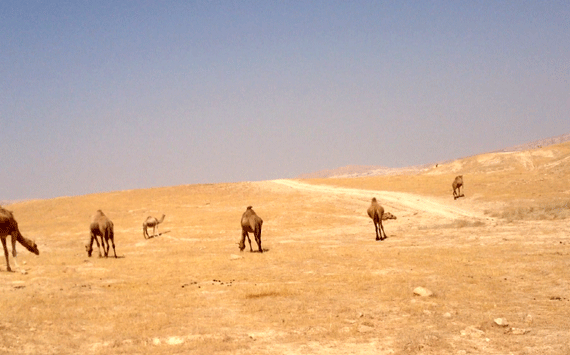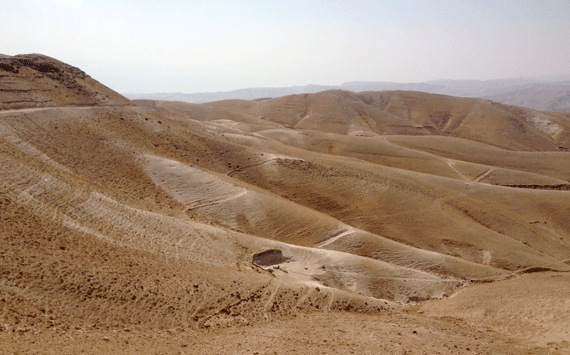|

|
|
 |
|
|
|
When you hear "wilderness," what do you
imagine? Barren desolation?
Demons, thirst, scorpions, snakes?
Or do you envision a quiet space for
solitude, meditation, revelation?
Or perhaps a combination of all of
these? |
|
|
|
Christian and Jewish traditions alike
have ambivalent attitudes towards the
wilderness. On the one hand, it's
a place of nearness to the Almighty.
Moses ascended the mountain in the
wilderness of Sinai to receive "the
stone tablets inscribed by the [very]
finger of God." (Exodus 31:18) On
the other hand, the wilderness is a
"land of fiery serpents, scorpions,
thirst" (Deuteronomy 8:15) and other
scary unknowns, provoking the darkest of
fears. And it was in the
wilderness where Jesus fasted 40 days
and 40 nights, struggling with Satan. |
|
|
|
 |
|
Photo:
Gila Yudkin |
|
Sheep and goats
grazing in Judean wilderness en route to
Jebbel Muntar |
|
|
|
One of my favorite sites in the
wilderness is Jebbel Muntar, Arabic for
"look out mountain." Believed to
be the Cliff of the Scapegoat, Jebbel
Muntar is accessible only by safari
vehicle.
|
|
|
|
 |
|
Photo:
Gila Yudkin |
|
Rock-carved cistern
near Judean desert "highway" |
|
|
|
Wrapped in windbreakers with a stock of
bottled water, we eagerly climb up into
a 30-seater safari truck which picks us
up early at our hotel. East of
Bethany we leave the black asphalt for
the brown stony "ancient paths" (as in
Jeremiah 6:16) bordered by fields of
sprouting barley. |
|
|
|
 |
|
Photo:
Gila Yudkin |
|
Camels grazing -- on
what??? |
|
|
|
En route to Jebbel Muntar we pass
through dozens of Beduin encampments and
note remnants of their once nomadic
existence reminiscent of the Biblical
wanderings in the desert. We stop
to observe the ancient lifestyle of the
Beduin and their solutions to the one
pervasive problem of the desert: lack of
water. Striking faces, dress,
tents and animals provide lots of photo
opps for us today. |
|
|
 |
|
Photo:
Gila Yudkin |
|
Summit of Jebbel
Muntar |
|
|
|
After a bumpy ride we reach Jebbel
Muntar, the highest peak in the Judean
Wilderness at 1625 feet. This
mount is associated with a ritual
practiced in Jesus' day on Yom Kippur,
the Day of Atonement. On that most
holy of days during the existence of the
second temple in Jerusalem, a "sacred"
lottery took place. It involved
two goats and two lots, one assigned to
each goat. One lot would read "for
the Lord" and that goat would be
sacrificed in the Temple. |
|
|
|
The other lot would read "for Azazel."
The high priest would lay all the sins
of Israel (and there were many!) upon
that goat. The goat would be led
out of the Temple courtyard, through the
Eastern Gate, up to the Mount of Olives. |
|
|
|
 |
|
Photo
courtesy of Wikipedia Commons |
|
The Scapegoat painted
by William Holman Hunt 1827-1910 |
|
|
|
Accompanied by the VIPs of Jerusalem,
the goat would be led from the Mount of
Olives along ten stations through the
wilderness of Judea. Once the goat
carrying all the sins of Israel reached
"the" precipice, it would be hurled over
so that its limbs separated from its
body, even before it reached the valley
floor. Today we believe that
Jebbel Muntar is that precipice over
which the goat was cast, taking with it
all the sins of Israel. |
|
|
|
This ritual was an adaptation of the
earlier Israelite practice of releasing
the goat out into the wilderness, as in
Leviticus 16. Maybe the priests
feared that the goat bearing all the
sins of Israel would wander back to
haunt them! So they hurled the
scapegoat (i.e. the goat that originally
escaped into the wilderness) off this
precipice. |
|
|
|
 |
|
Photo:
Gila Yudkin |
|
Desert landscape seen from Jebbel Muntar
|
|
|
|
Do you think, as I do, that the ritual
of the scapegoat brings to mind the
actions of the people of Nazareth who
took Jesus "to the brow of the hill on
which their town was built, so that they
might hurl him off the cliff?" (Luke
4:29) |
|
| The
wilderness experience often ignites a
heated examination of our attitudes (and
fears) towards the wilderness, solitude,
revelation. In every group the
discussion veers in a different
direction. |
|
 |
|
Photo:
Gila Yudkin |
|
We may see something
like this on our wilderness day |
|
|
|
 |
|
Photo:
Gila Yudkin |
|
If it's spring, we may
see a scene like this..... |
|
|
|
And at some point I'll quote Proverbs
21:19: |
|
Better to dwell in a wilderness
Then with a contentious and angry
woman!"
|
|
That surely will provoke a reaction! |
|

